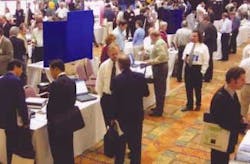The 22nd International Congress on Applications of Lasers & Electro Optics (ICALEO; Oct. 13–16, Jacksonville, FL) hosted by the Laser Institute of America (Orlando, FL) showed great vitality, with more than 450 attendees and presenters from 23 countries. The depth of information presented demonstrated that innovation continues in this field despite the recent years of economic stress.
The congress had two major themes. The Laser Materials Processing Conference was the larger group, with 140 papers, while the concurrently run Laser Microfabrication Conference had 58 papers. In addition, there were 31 judged poster presentations, with Won-seok Chang of the Korea Institute of Machinery and Materials (Deajeon, South Korea) earning first prize for his topic, "Ultrafast laser lithography using self-assembled monolayers (SAMs)."
The opening plenary session focused on several variations of direct metal deposition (DMD), now a commercially viable technology for building models or a usable part directly from CAD (computer-aided design) files. One presentation described how DMD technology would create a Ti 6-4 preform (Ti 6-4 is an aircraft-grade titanium alloy that contains some aluminum and vanadium) for F-18 aircraft center-wing spars using an 18-kW CO2 laser. The parts created by this process can be up to 4 × 10 ft × 12 in. thick and larger. The Ti 6-4 deposited by the laser-based process has virtually the same properties as forged Ti 6-4, resulting in a rough part ready for final machining with approximately 70% in material savings and with only 50% of the machining cost of a solid forging. Another presentation described DMD technology for directly writing high-density silver circuit interconnects that are 25 µm wide on 50-µm centers.
The Laser Materials Processing Conference focused on several major processing areas. Recent improvements in current techniques were covered in sessions on direct metal-fabrication processes and systems, laser welding and welding phenomena focusing on keyhole dynamics, hybrid welding combining lasers and arc welding, laser powder-deposition processes or cladding, laser surface modifications, and laser cutting processes and technology.
A second group of sessions focused on aspects adjunct to laser processing, including optics technology for laser processing (including a new and promising fiberoptic system for CO2 lasers), laser process sensing and control technology, modeling of laser/material interactions, and diode lasers for laser materials processing.
Some of the most cutting-edge information was presented in sessions on laser-induced breakdown spectroscopy, diverse novel laser processes (investigating subjects from laser photochemical drilling to large-diameter hole drilling in rock), laser joining of polymers, and new lasers and laser systems technologies that included a diode-end-pumped slab laser, as well as ultrahigh-power Ytterbium fiber lasers emitting at powers from 10 to 100 kW.
Diode and diode-pumped laser sources were a constant theme throughout the sessions, with emission wavelengths ranging from 2 µm to as short as 198 nm. The reliability of diode-based laser sources is dramatically improving. Lifetimes of some configurations exceed 100,000 hours, and most systems comfortably demonstrate lifetimes of 10,000 hours or more.
Microfabrication
Main themes at the Laser Microfabrication Conference included lasers for optics and photonics fabrication, microwelding (especially for medical applications), micromachining ultrasmall features, industrial applications of laser micromachining, modeling of ultrafast laser processing into the femtosecond region, and capabilities and designs of systems and lasers for micro machining. Prevalent in the Microfabrication Conference was the idea of gaining a better understanding of the laser/material interactions involved when producing very small features. Material microstructures and chemical composition were discussed in relation to wavelength, pulse length, pulse shape, fluence, peak power, and energy distribution. Features of 1 to 5 µm were commonly demonstrated with laser microfabrication and even some examples of 100-nm features were presented.
The vendors' evening exhibition was filled with high-quality discussion. Attendees had direct access at vendors' tables to the companies' best technical experts and could discuss technical considerations up close and in depth (see figure).
This year's ICALEO also included six comprehensive tutorials on industrial subjects. These included introduction to micromachining using UV lasers, an overview of laser microfabrication from milliseconds to femtoseconds, fiber lasers and their possibilities, building a compelling economic case to drive laser technology implementation, and laser surface melting and rapid solidification.
The Laser Institute of America is producing a CD of the actual conference slides and spoken presentations; this CD captures presentations at which there were no written documents and also captures information the speakers gave in their spoken presentation that was not available when the written presentation was submitted (see www.laserinstitute.org). A second CD containing the written presentations is also available.
The next ICALEO will be in held in San Francisco, CA, Oct. 4–7, 2004.
William E. Lawson is the chief technical officer of Preco Laser Systems, Somerset, WI; he is also the 2003 president of the LIA.
